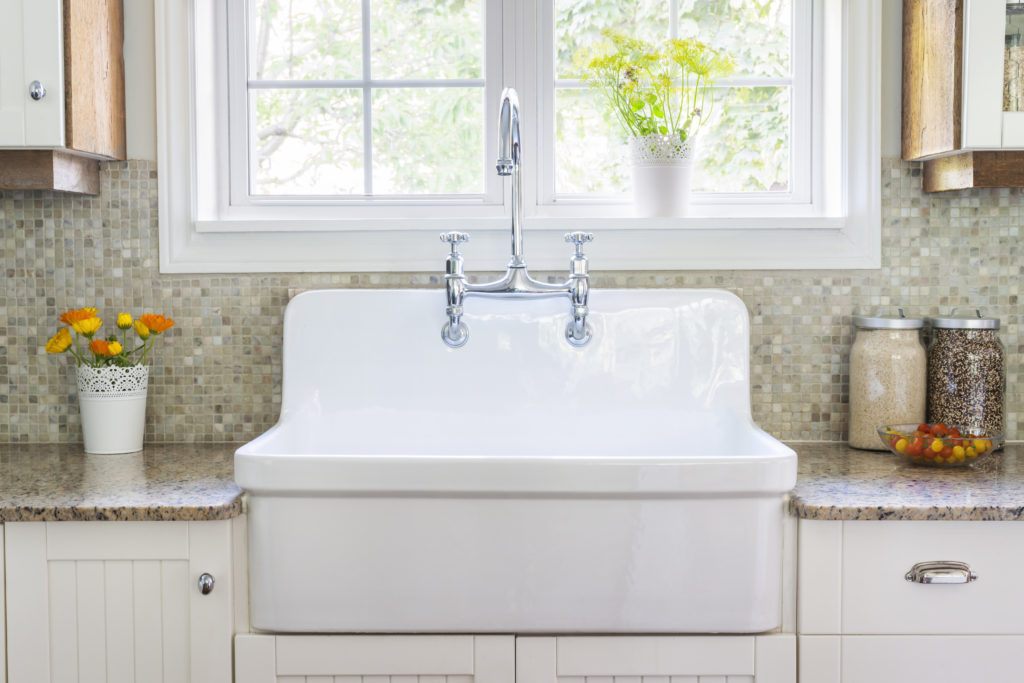The sink is a central feature in any kitchen. There we wash our hands, wash our dishes, wash our food, not to mention strain our culinary creations and even toss out crumbs and other food waste. There are a lot of sink options available when you build or remodel a kitchen, and you have to choose the right one for your space.
As you choose your sink, the unit itself, not the faucet, consider a typical load volume. Do you do a lot of cooking? Will a lot of people be using the sink? Do you have a dishwasher or will the dishes mostly be cleaned by hand? Will you need the sink for other things, like bathing a baby? Of course, you also want to take your sense of style and the design of the rest of the kitchen into account as well to make sure your sink fits the scene.

When choosing a sink for your kitchen, there are three qualities you should consider carefully: how you will mount it, what you want it to be made of, and if you want the sink to be subdivided.
Mounting
The two most common ways to mount a sink: drop-in and undermount, though a few more stylistic sink options are available. When making your choice, consider your countertops carefully. Not all sink options are compatible with all countertop materials.
Drop-In Sinks
Drop-in sinks sit directly on the countertop, creating a lip around the edge. For this reason, they are also called top-mounted kitchen sinks and self-rimming sinks. Because they are not flush, they make cleaning a bit more challenging, but they are compatible with any kind of countertop.
Undermount Sinks
Undermounts sinks, as their name suggests, attach to the underside of the counter. This removes the lip around the sink, making the unit flush with the countertop. These sink options are streamlined and facilitate an easy cleanup since you can sweep crumbs and spills right into the sink.
You sacrifice countertop versatility for a discrete and streamlined appearance, however, since not all countertop materials are strong enough to hold them. Durable stone like quartz, granite, and marble are sufficiently strong.
Farmhouse Sinks
Farmhouse sinks are a very specific kind of sink design. They are especially large and deep and their front-facing side is exposed instead of surrounding the sink’s perimeter with countertop. This kind of sink speaks of luxury, which is reflected in its price tag.

Integrated Sinks
Deciding to get an integrated sink is no small matter, since the sink and the countertop are one unit. This makes the sink rimless, easy to clean, and very modern as well as very expensive with a very involved installation process. Integrated sinks are usually made of stone or metal.
Materials
When choosing the material for your sink, consider the material’s sturdiness, antimicrobial properties, and how well it will fit in with the rest of your kitchen’s design.
Stainless Steel
Well-loved because it is budget-friendly and easy to clean, stainless steel is a common sink material choice. The metal holds up well with frequent use.
Stone
Stone sinks are durable but do risk being chipped or stained with heavy use. Granite and marble are the most common sink options made of stone.
Acrylic
Acrylic sinks are relatively inexpensive but quite durable despite being very lightweight. They are also kinder to dishes clinking around the sink.
Enamel
Enamel sinks are stainless steel sinks covered with a composite of enamel and glass. They look beautiful, and appealingly smooth, and have a bit of a sparkle to them.

Divided Sink Options
While most sinks follow the same general shape, you can choose whether you want the simplicity of a single bowl or the functionality of two.
Single Bowl
Single bowl sinks are straightforward and they often allow for more depth. They are a good fit for small spaces but, as is the case with farmhouse sinks, can also be as big or as deep as your counter will allow. Single bowl sinks are generally easier to clean.
Double Bowl
Double bowl sinks make multitasking a breeze. You can fill one side with sudsy water and the other with dishes that need to be rinsed, or follow another system of your choice. You also have a lot of variety available in how you level the bowls of your sink. They can be of equal height, or one can be higher than the other. One bowl can be narrow and the other wide or you can make them of equal widths. Be mindful of your available space since double bowl sink options tend to take up more room than those with just one bowl.
Add a Drainboard
It is possible to divide a sink without utilizing two bowls. The addition of a drainboard adds a sloped space whereon you can set things like drying dishes or produce. The drainboard slopes so all moisture runoff drains directly into the sink.



CONTACT US: 801.797.0345